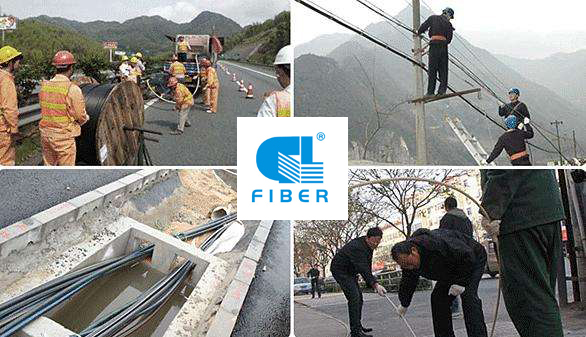Communication optical fiber cables are more commonly used in overhead, direct buried, pipelines, underwater, indoor and other adaptive laying optical cables. The laying conditions of each optical cable also determine the difference between the laying methods. GL probably summarized a few points:
Aerial optical cable is an optical cable used on poles. This kind of laying method can use the original overhead open wire pole road, saving construction costs and shortening the construction period. Overhead optical cables are hung on electric poles and are required to be able to adapt to various natural environments. Overhead optical cables are susceptible to natural disasters such as typhoons, ice and floods, and are also susceptible to external forces and weakening of their own mechanical strength. Therefore, the failure rate of overhead optical cables is higher than that of direct-buried and ducted optical fiber cables. Generally used for long-distance lines of Class 2 or below, and suitable for dedicated network optical cable lines or some local special sections.
There are two ways to lay overhead optical cables:
1. Hanging wire type: first fasten the wire on the pole, and then hang the optical cable on the hanging wire with a hook, and the load of the optical cable is carried by the hanging wire.
2. Self-supporting type: use a self-supporting structure of the optical cable, the optical cable is in the shape of "8", the upper part is a self-supporting line, and the load of the optical cable is carried by the self-supporting line.
Directly buried optical cable: This optical cable has steel tape or steel wire armor outside, and is directly buried underground. It requires resistance to external mechanical damage and soil corrosion. Different protective layer structures should be selected according to different use environments and conditions. For example, in areas with pests and rats, optical cables with protective layers that prevent pests and rats should be used. Depending on the soil quality and the environment, the depth of the fiber optic cable buried in the ground is generally between 0.8 meters and 1.2 meters. During laying, care must be taken to keep the strain of the optical fiber within the allowable limit.
Duct Fiber Optic Cable: the laying of pipes is generally in urban areas, and the environment for laying of pipes is better, so there are no special requirements for the optical cable sheath, and no armoring is required. Before laying the pipeline, the length of the laying section and the location of the connection point must be selected. When laying, mechanical bypass or manual traction can be used. The pulling force of one pulling should not exceed the allowable tension of the optical cable. The materials for the pipeline can be selected from concrete, asbestos cement, steel pipe, plastic pipe, etc. according to geography.
Underwater Optical Cables are optical cables that are laid under water across rivers, lakes and beaches. The laying environment of this kind of optical cable is much worse than that of pipeline laying and direct buried laying. The underwater optical cable must adopt a steel wire or steel tape armored structure, and the structure of the sheath must be considered comprehensively according to the hydrogeological conditions of the river. For example, in stony soils and seasonal riverbeds with strong scouring properties, where the optical cable suffers from abrasion and high tension, not only thick steel wires are required for armoring, but even double-layered armoring is required. The construction method should also be selected according to the river width, water depth, flow rate, river bed, flow rate, and river bed soil quality.
The laying environment of underwater optical cables is much stricter than that of direct buried optical cables, and it is much more difficult to repair faults and measures. Therefore, the reliability requirements of underwater optical cables are higher than that of direct buried optical cables. Submarine optical cables are also underwater cables, but the laying environment conditions are more stringent and more demanding than general underwater optical cables. The service life of submarine optical cable systems and their components is required to be more than 25 years.


